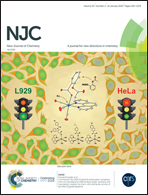Dihydroxo-bridged diuranyl(vi) complexes with 2-((2-(6-chloropyridazin-3-yl)hydrazono)methyl)-4-R-phenols: structural insights and visible light driven photocatalytic activities†
Abstract
Two new dihyroxo-bridged diuranyl(VI) complexes with the molecular formula [(UO2)2(μ-OH)2(Ln)2] (1 and 2) were synthesized in good yields (∼64%) by reacting equimolar amounts of [UO2(OAc)2]·2H2O and 2-((2-(6-chloropyridazin-3-yl)hydrazono)methyl)-4-R-phenols (HLn where n = 1 and 2 for R = H and OMe, respectively) in dimethylformamide. Both complexes were characterized by elemental analysis, and various spectroscopic and cyclic voltammetric measurements. The X-ray crystal structures of the two complexes crystallized as solvated species showed the rare {(UO2)2(μ-OH)2}2+ core where each metal centre is in a distorted pentagonal-bipyramidal N2O5 coordination sphere assembled by two axial oxo atoms, two equatorial bridging hydroxo-O atoms and the equatorial N,N,O-donor (Ln)−. The solvated complexes assemble through intermolecular bifurcated N–H⋯(O,O) and simple O–H⋯O and N–H⋯O hydrogen bonding interactions and form supramolecular one-dimensional chain-like and three-dimensional network structures in the crystal lattices. The infrared and proton NMR spectroscopic characteristics of the two complexes corroborate their molecular structures. The electronic spectra of 1 and 2 display three strong absorption bands in the range of 405–301 nm. A metal centred irreversible reduction having a Epc of approximately −1.06 V (vs. Ag/AgCl) was observed in the cyclic voltammograms of 1 and 2. Both complexes are photocatalytically active in the degradation of rhodamine B (RhB) and methylene blue (MB) under visible light irradiation. Photodegradation of RhB up to a maximum of 96% and that of MB up to a maximum of 85% was achieved in 150 and 180 min, respectively, using 2 as a catalyst.



 Please wait while we load your content...
Please wait while we load your content...